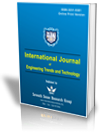Spectral Enhancement of GFDM Using Gaussian Pulse Shaping
Spectral Enhancement of GFDM Using Gaussian Pulse Shaping |
||
 |
 |
|
| © 2025 by IJETT Journal | ||
| Volume-73 Issue-4 |
||
| Year of Publication : 2025 | ||
| Author : Buthaina M. Omran, Yamaan E. Majeed |
||
| DOI : 10.14445/22315381/IJETT-V73I4P102 | ||
How to Cite?
Buthaina M. Omran, Yamaan E. Majeed, "Spectral Enhancement of GFDM Using Gaussian Pulse Shaping," International Journal of Engineering Trends and Technology, vol. 73, no. 4, pp. 17-23, 2025. Crossref, https://doi.org/10.14445/22315381/IJETT-V73I4P102
Abstract
Generalized Frequency Division Multiplexing GFDM is one of the multicarrier modulation techniques used in 5G that was derived from Orthogonal Frequency Division Multiplexing (OFDM). The main feature of GFDM is a pulse shaping the transmitted symbol to enhance the power spectral density of the transmitted signal and decrease the out-of-band (OOB) radiations, which will increase the spectral efficiency of the transmitted signal. In this paper, the Gaussian pulse shaping filter was introduced to shape the transmitted symbols of a simulated GFDM system. A comparison with the conventional shaping functions was also made to evaluate the Gaussian pulse shaping filter results. The simulated results show that the spectral efficiency was improved by (14.2) dB without effect on the overall system performance.
Keywords
GFDM, Gaussian filter, Pulse shaping, Spectral efficiency, 5G.
References
[1] Ivo Bizon Franco de Almeida et al., “5G Waveforms for IoT Applications,” IEEE Communications Surveys & Tutorials, vol. 21, no. 3, pp. 2554-2567, 2019.
[CrossRef] [Google Scholar] [Publisher Link]
[2] Mohammad Hadi Abbaszadeh, Babak H. Khalaj, and Afrooz Haghbin, “Optimum Low Complexity Filter Bank for Generalized Orthogonal Frequency Division Multiplexing,” EURASIP Journal on Wireless Communications and Networking, vol. 2018, no. 1, pp. 1-14, 2018.
[CrossRef] [Google Scholar] [Publisher Link]
[3] Ching-Lun Tai, Tzu-Han Wang, and Yu-Hua Huang, “An Overview of Generalized Frequency Division Multiplexing (GFDM),” Arxiv, pp. 1-14, 2020.
[CrossRef] [Google Scholar] [Publisher Link]
[4] Fei Li et al., “Design and Performance of a Novel Interference-Free GFDM Transceiver with Dual Filter,” IEEE Transactions on Vehicular Technology, vol. 68, no. 5, pp. 4695-4706, 2019.
[CrossRef] [Google Scholar] [Publisher Link]
[5] Zee Ang Sim et al., “Performance of GFDM Systems Using Quadratic Programming Pulse Shaping Filter Design,” IEEE Access, vol. 8, pp. 37134-37146, 2020.
[CrossRef] [Google Scholar] [Publisher Link]
[6] Randy Verdecia Peña, and Humberto Millán Vega, “Number of Subcarrier Filter Coefficients in GFDM System: Effect on Performance,” Ingenius, vol. 23, pp. 53-61, 2020.
[CrossRef] [Google Scholar] [Publisher Link]
[7] Behzad Mozaffari Tazehkand, Mohammad Reza Ghavidel Aghdam, and Reza Abdolee, “Optimal Complex-Valued Prototype Filter Design for GFDM Systems,” Arxiv, 2023.
[CrossRef] [Google Scholar] [Publisher Link]
[8] Mohammad Towliat, Morteza Rajabzadeh, and Seyyed Mohammad Javad Asgari Tabatabaee, “On the Noise Enhancement of GFDM”, IEEE Wireless Communications Letters, vol. 9, no. 8, pp. 1160-1163, 2020.
[CrossRef] [Google Scholar] [Publisher Link]
[9] Peng Wei et al., “N-Continuous Signaling for GFDM,” IEEE Transactions on Communications, vol. 68, no. 2, pp. 947-958, 2020.
[CrossRef] [Google Scholar] [Publisher Link]
[10] Nicola Michailow et al., “Generalized Frequency Division Multiplexing for 5th Generation Cellular Networks,” IEEE Transactions on Communications, vol. 62, no. 9, pp. 3045-3061, 2014.
[CrossRef] [Google Scholar] [Publisher Link]
[11] Seyyed Mohammad Javad Asgari Tabatabaee, Morteza Rajabzadeh, and Mohammad Towliat, “A Novel Low-Complexity GFDM Relay Communication System: Relay Selection and Filter-and-Forward,” IEEE Transactions on Signal Processing, vol. 69, pp. 5147-5158, 2021.
[CrossRef] [Google Scholar] [Publisher Link]
[12] Ersin Ozturk, Ertugrul Basar, and Hakan Ali Cirpan, “Generalized Frequency Division Multiplexing with Index Modulation,” IEEE Globecom Workshops, Washington, DC, USA, pp. 1-6, 2016.
[CrossRef] [Google Scholar] [Publisher Link]
[13] Ginne Rajesh Mehra, “FPGA Based Gaussian Pulse Shaping Filter Using Distributed Arithmetic Algorithm,” International Journal of Scientific & Engineering Research, vol. 4, no. 8, pp. 711-715, 2013.
[Google Scholar] [Publisher Link]
[14] Maximilian Matthé et al., “Influence of Pulse Shaping on Bit Error Rate Performance and Out of Band Radiation of Generalized Frequency Division Multiplexing,” IEEE International Conference on Communications Workshops, Sydney, NSW, Australia, pp. 43-48, 2014.
[CrossRef] [Google Scholar] [Publisher Link]
[15] Ching-Lun Tai, Borching Su, and Cai Jia, “Frequency-Domain Decoupling for MIMO-GFDM Spatial Multiplexing,” ICASSP 2019 - 2019 IEEE International Conference on Acoustics, Speech and Signal Processing, Brighton, UK, pp. 4799-4803, 2019.
[CrossRef] [Google Scholar] [Publisher Link]
[16] Shilpa Shukla, Puran Gour, “The Parametric Analysis of Gaussian Pulse Shaping Filter in WCDMA Network,” International Journal of Engineering Research & Technology, vol. 2, no. 12, pp. 919-922, 2013.
[Google Scholar] [Publisher Link]
[17] N. Krishnapura et al., “A Baseband Pulse Shaping Filter for Gaussian Minimum Shift Keying,” 1998 IEEE International Symposium on Circuits and Systems, Monterey, CA, USA, pp. 249-252, 1998.
[CrossRef] [Google Scholar] [Publisher Link]
[18] Robert Bogdan Staszewski, and Poras T. Balsara, All-Digital Frequency Synthesizer in Deep-Submicron CMOS, John Wiley & Sons, pp. 1-280, 2006.
[Google Scholar] [Publisher Link]

